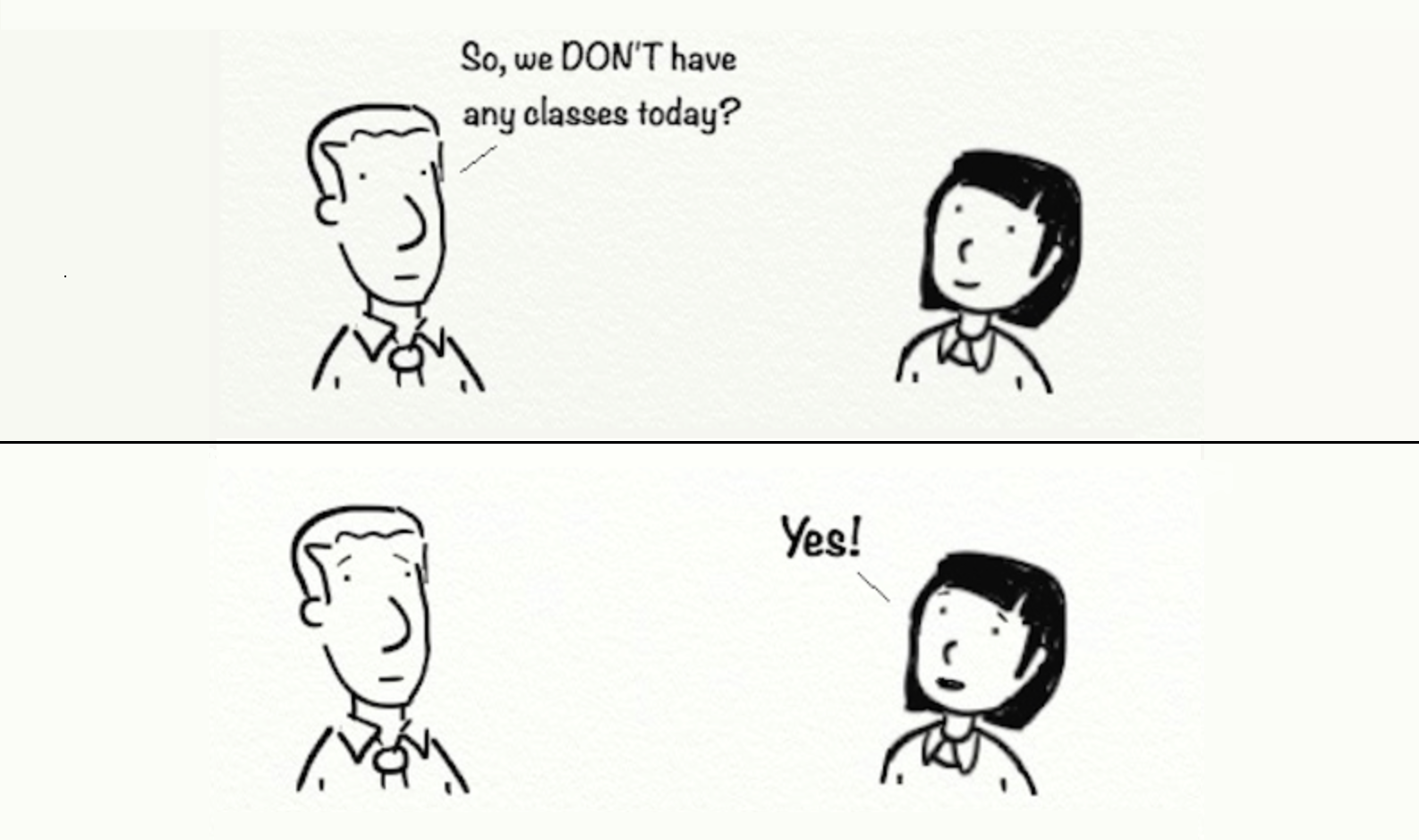
You can learn all the words and practice all the kanji, but there’s one little Japanese language quirk that will almost certainly trip you up when you first encounter it.
An enormous number of westerners who come to Japan on a work visa do so to teach English. Often, speaking Japanese is not a prerequisite for being a native English teacher or teaching assistant in Japan (in fact, many language schools would rather you didn’t, so that you’re not tempted to use Japanese in the classroom), but this very often means that how well you and your coworkers communicate will depend entirely on their English-speaking ability, at least to begin with.
In most cases, with the help of a few gestures and repetition, everything goes relatively smoothly. But even when your Japanese coworker speaks close to perfect English, there’s one major difference between English and Japanese (and Korean, and a number of other languages, for that matter) that causes sometimes comical levels of confusion between the two parties involved: answering a negative statement.
Anyone who has worked in Japan as an English teacher will undoubtedly have had at least one conversation that went like this:
Regardless of whether it’s a lack of classes, hair on your head or money in your wallet, when a Japanese person responds to a native English-speaker’s negative question, or vice-versa, there’s almost always a moment or of confusion before they’re both on the same page.
You see, in Japanese, the following exchange would make perfect sense.
A: あら!牛乳ない!買いに行かなきゃ。
Ara! Gyuunyuu nai! Kai ni ikanakya.
Ah, there’s no milk! I’d better go and buy some.
B: 牛乳ないって?
Gyuunyuu nai tte?
We don’t have any milk?
A: うん。
Un.
Yes.
Of course, in English, the last utterance here would usually be “No (there isn’t any milk),” but in Japanese, the speaker, rather than affirming the presence or absence of said delicious cow-juice, either confirms or denies the statement that the other person just made. Rather than meaning “Yes (there’s no milk)”, this final “うん/un” actually means “Yes, what you’ve just said is true.”
Still confused? A few more examples:
Question: You aren’t going to the party?
Japanese response: Yes (that’s right; I’m not going).
English response: No (I’m not going).
Question: Oh, so you don’t like dogs?
Japanese response: Yes (that’s right; I don’t like dogs).
English response: No (I don’t like dogs).
Question: There aren’t any trains after 1am?
Japanese response: Yes, there aren’t any.
English response: No, there aren’t any.
I suppose the key thing for English speakers to remember is that Japanese yes/no responses to negative questions are intended to tell the questioner that whatever they’ve just said either is or isn’t the case. When you think about it, in a funny way it’s English, rather than Japanese, that’s the quirky one…


 Seven mistakes foreigners make when speaking Japanese—and how to fix them
Seven mistakes foreigners make when speaking Japanese—and how to fix them Westerners in Japan – do they really ALL speak English? 【Video】
Westerners in Japan – do they really ALL speak English? 【Video】 What’s wrong with English education in Japan? Pull up a chair…
What’s wrong with English education in Japan? Pull up a chair… “We wasted so much time in English class” — Japanese Twitter user points out major teaching flaw
“We wasted so much time in English class” — Japanese Twitter user points out major teaching flaw Foreign English teachers in Japan pick their favorite Japanese-language phrases【Survey】
Foreign English teachers in Japan pick their favorite Japanese-language phrases【Survey】 One of Japan’s rarest sweets is a sell-out hit that looks and tastes like frost
One of Japan’s rarest sweets is a sell-out hit that looks and tastes like frost “Not paying any dating expenses at all” listed as domestic violence by Japanese government agency
“Not paying any dating expenses at all” listed as domestic violence by Japanese government agency Starbucks Japan gifts us with the Matcha Classic Green Tea Latte for a limited time
Starbucks Japan gifts us with the Matcha Classic Green Tea Latte for a limited time Where’s the happiest place for foreigners to live in Japan? Study investigates
Where’s the happiest place for foreigners to live in Japan? Study investigates Over 800 Studio Ghibli anime world paintings compiled in beautiful new hardcover art book【Pics】
Over 800 Studio Ghibli anime world paintings compiled in beautiful new hardcover art book【Pics】 Studio Ghibli releases new Panda! Go, Panda! goods for New Year
Studio Ghibli releases new Panda! Go, Panda! goods for New Year Adorable baby hippo Moo Deng is now an adorable Mister Donut donut!
Adorable baby hippo Moo Deng is now an adorable Mister Donut donut! Starbucks Japan is calling it quits with paper straws
Starbucks Japan is calling it quits with paper straws Studio Ghibli tea blends contain ingredients inspired by My Neighbour Totoro
Studio Ghibli tea blends contain ingredients inspired by My Neighbour Totoro Japan’s Kanji of the Year announced, shows the bright and dark spots of 2024【Video】
Japan’s Kanji of the Year announced, shows the bright and dark spots of 2024【Video】 Studio Ghibli coasters keep your drinks hot and your heart warm this winter
Studio Ghibli coasters keep your drinks hot and your heart warm this winter Japan’s top 10 food travel destination prefectures【Survey】
Japan’s top 10 food travel destination prefectures【Survey】 Japan’s tap-to-pay Suica train card system aims to go tapless with walk-through gates, location data scans
Japan’s tap-to-pay Suica train card system aims to go tapless with walk-through gates, location data scans Starbucks teams up with 165-year-old Kyoto doll maker for Year of the Snake decorations【Photos】
Starbucks teams up with 165-year-old Kyoto doll maker for Year of the Snake decorations【Photos】 Japanese city paints well-known prostitution street bright yellow, adds fish art【Video】
Japanese city paints well-known prostitution street bright yellow, adds fish art【Video】 Sushi Bears restaurant opens in Tokyo, offers exactly what its name promises【Photos】
Sushi Bears restaurant opens in Tokyo, offers exactly what its name promises【Photos】 Stunning ukiyo-e art experience floats over to Tokyo for its latest exhibition
Stunning ukiyo-e art experience floats over to Tokyo for its latest exhibition Possessing Harry Potter’s Sword of Godric Gryffindor is now illegal in Japan
Possessing Harry Potter’s Sword of Godric Gryffindor is now illegal in Japan One of Japan’s most beautiful hot spring towns announces new limits on number of day trippers
One of Japan’s most beautiful hot spring towns announces new limits on number of day trippers Uniqlo announces first-ever collaboration with horror manga master Junji Ito【Photos】
Uniqlo announces first-ever collaboration with horror manga master Junji Ito【Photos】 J-pop mega star Ado reveals she’s been living in the U.S., may not understand language acquisition
J-pop mega star Ado reveals she’s been living in the U.S., may not understand language acquisition Ghibli’s Princess Mononoke teams up with Foxfire for outdoor apparel collaboration【Photos】
Ghibli’s Princess Mononoke teams up with Foxfire for outdoor apparel collaboration【Photos】 Studio Ghibli releases new range of cardigans for anime fans
Studio Ghibli releases new range of cardigans for anime fans Japan’s most popular castle raising ticket prices by up to 200 percent for non-local tourists
Japan’s most popular castle raising ticket prices by up to 200 percent for non-local tourists Furikake rice seasoning sales are soaring, which is bad news for Japan as a whole
Furikake rice seasoning sales are soaring, which is bad news for Japan as a whole Studio Ghibli heroine cardigans give you warmth and strength to face everyday challenges
Studio Ghibli heroine cardigans give you warmth and strength to face everyday challenges McDonald’s new Happy Meals offer up cute and practical Sanrio lifestyle goods
McDonald’s new Happy Meals offer up cute and practical Sanrio lifestyle goods Foreign tourists on Shinkansen bullet train break suitcase etiquette, angering local passengers
Foreign tourists on Shinkansen bullet train break suitcase etiquette, angering local passengers [Deleted] Article written for April Fool’s Day 2018
[Deleted] Article written for April Fool’s Day 2018 Japanese government to make first change to romanization spelling rules since the 1950s
Japanese government to make first change to romanization spelling rules since the 1950s Foreigner’s request for help in Tokyo makes us sad for the state of society
Foreigner’s request for help in Tokyo makes us sad for the state of society Japanese convenience store Family Mart announces abolishment of eat-in spaces
Japanese convenience store Family Mart announces abolishment of eat-in spaces Life-size vibrating Legend of Zelda Master Sword for sale from Nintendo【Photos】
Life-size vibrating Legend of Zelda Master Sword for sale from Nintendo【Photos】 Princesses, fruits, and blacksmiths: Study reveals the 30 most unusual family names in Japan
Princesses, fruits, and blacksmiths: Study reveals the 30 most unusual family names in Japan Studio Ghibli releases free-download board game — Here’s how to play it without reading Japanese
Studio Ghibli releases free-download board game — Here’s how to play it without reading Japanese Japanese expat remembers the words that changed his life when he started working in Australia
Japanese expat remembers the words that changed his life when he started working in Australia Learners beware! Even Japanese people agree that their language can be really ambiguous
Learners beware! Even Japanese people agree that their language can be really ambiguous English conversation school in Japan has clever reminder that students don’t have to be perfect
English conversation school in Japan has clever reminder that students don’t have to be perfect Over half of Japanese students in nationwide test score zero percent in English speaking section
Over half of Japanese students in nationwide test score zero percent in English speaking section Japanese students despair over the many, MANY ways you can describe a dead flower
Japanese students despair over the many, MANY ways you can describe a dead flower Foreign English teacher in Japan calls student’s ability garbage, says it was an “American joke”
Foreign English teacher in Japan calls student’s ability garbage, says it was an “American joke” Under 35 percent of middle school English teachers in Japan meet government proficiency benchmark
Under 35 percent of middle school English teachers in Japan meet government proficiency benchmark Nihon-no: Is an entirely English-speaking village coming to Tokyo?
Nihon-no: Is an entirely English-speaking village coming to Tokyo? RocketNews24’s six top tips for learning Japanese
RocketNews24’s six top tips for learning Japanese The Japanese you learn at school vs the Japanese used in Japan【Video】
The Japanese you learn at school vs the Japanese used in Japan【Video】 Are Japan’s efforts at internationalization succeeding or not?
Are Japan’s efforts at internationalization succeeding or not? Hello Kitty isn’t a cat!? We called Sanrio to find out!
Hello Kitty isn’t a cat!? We called Sanrio to find out! Japanese Twitter user embarrassed to learn why American friend is studying Japanese, not Chinese
Japanese Twitter user embarrassed to learn why American friend is studying Japanese, not Chinese Wait, the Japanese word daijoubu can mean both “yes” and “no?” Why? HOW?!?
Wait, the Japanese word daijoubu can mean both “yes” and “no?” Why? HOW?!? Top 10 most irritating Japanese borrowed words – Part 2 (The people’s top 10)
Top 10 most irritating Japanese borrowed words – Part 2 (The people’s top 10) Proclaim dedication to your special pirate-someone with deluxe One Piece-inspired jewelry
Proclaim dedication to your special pirate-someone with deluxe One Piece-inspired jewelry
Leave a Reply